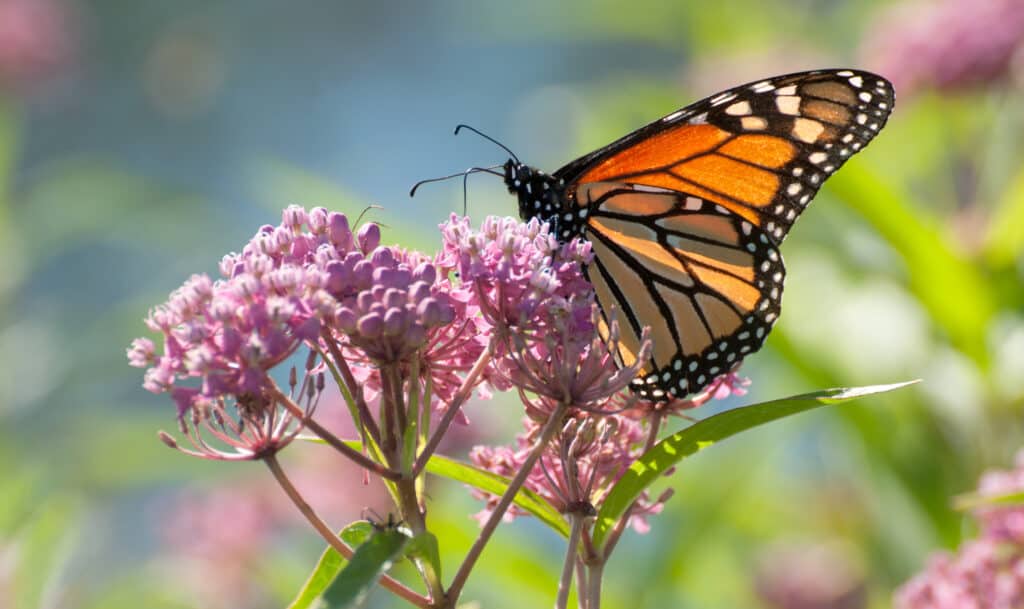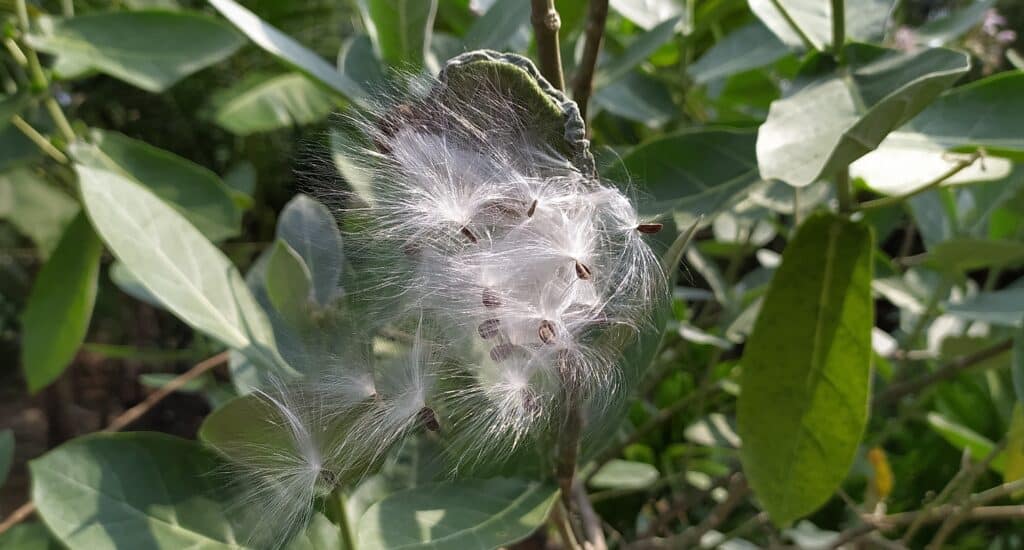Milkweed is a wildflower that’s essential to the monarch butterfly lifecycle and a nectar-rich source of food for our pollinators, however it is toxic and considered a weed by many. Let’s find out more about milkweed including whether it’s perennial or annual and what it has to do with lifejackets.
Milkweed: Perennial or Annual?
Milkweed is a perennial not an annual.
There are many species of milkweed and they are all perennial herbs that set seed, die back and re-grow the following spring.
What Is Milkweed?
Milkweed is the common name for a group of flowering plants in the asclepias genus. There are over 200 species of milkweed in the asclepias genus. They are native to the Americas and Africa.
Milkweeds are perennial, not annual, and they are named after the milky white sap in their stems. The genus was named in 1753 after Asclepius the ancient Greek and Roman god of healing. They have long rhizome roots and strong stems that can reach a whopping 6.5 feet (two meters) tall. Flowers are bell-shaped and their color ranges from pink to white. Milkweed has a beautiful sweet scent that is underappreciated by gardeners that consider it a weed.
Even though they are considered a common weed by some, milkweeds have complicated flowerheads, described by botanists as one of the most complex in the entire plant kingdom. They have outer petals that bend backwards to reveal a hooded structure that contains pollen sacs instead of fine pollen grains.
When pollinators land on milkweed, their feet slide into the sacs and they fly away carrying a whole bag of pollen! Monarch butterflies are not the best milkweed pollinators despite their essential connection. Instead, it’s large wasps and bees that carry away the most pollen sacs.
Throughout history, milkweed has been harvested and used for medicine. Popular uses included contraceptives, cancerous tumors, warts, and backache! Today milkweed is under investigation for potential anti-cancer and anti-ulcer properties.

Despite their strong association with the milkweed plant, Monarch butterflies are not the most its important pollinators.
©Nancy Bauer/Shutterstock.com
How Long Do Perennial Plants Live For?
Perennial plants live for more than two years. Some perennials look as though they have died in the winter months. This is totally normal! Deciduous perennials lose their foliage and stems, dying back to a rootball so they can survive the cold months. They will re-grow when spring rolls around. Some perennials are easier to identify because they are evergreen and don’t die back.
Plants that only flower for one year are called annuals. They germinate, grow, flower, and produce their seeds all in one growing season. Annuals are often used as bedding plants.
There’s another common plant category called biennials. Biennials are often mistakenly thought to flower twice a year. Bi means two, so this isn’t too much of a gaff. Bi in biennial refers to their two-year lifecycle. Biennials germinate in year one, then flower and seed in year 2 before dying off.
What Does Milkweed Look Like When It Starts To Grow?
Milkweed is perennial, not annual, and it can take as long as three years to develop its iconic flowers!
Young, newly sprouted milkweed has a strong fleshy stem, but most of its energy is given to establishing a strong root that’s needed to survive drought and frost – as well as very hungry caterpillars. Sometimes a young milkweed plant won’t germinate until July and will remain only a few inches in height for the year. It will have small green lance-shaped leaves.
In year two milkweeds put on leafy growth, enough for Monarch butterflies to sense its chemicals through their feet. It may grow to one or two feet in height but refrain from flowering. Milkweed can be identified by its broad or lance-shaped leaves that cover a tall and waving upright stem. Check the map to identify what species grow in your area.
In year three, milkweed usually flowers unless there’s an extreme drought. Its white or pink flowers are instantly recognizable and they are usually smothered in pollinators.

Milkweed flowers are popular food for caterpillars.
©Cathy Keifer/Shutterstock.com
Is Milkweed Poisonous?
Yes, most milkweed species are poisonous to people and pets. It’s the cardiac glycoside chemicals that cause diarrhea, vomiting, shortness of breath, confusion and collapse. If large amounts are eaten it can be fatal. Milkweed is more dangerous to grazing animals than humans because they are more likely to eat it. The ASPCA list milkweed as toxic to dogs, cats, and horses.
Despite its toxic chemicals milkweed is highly attractive to certain species who depend on it for survival even though it tries to kill them! We are of course talking about the monarch butterfly.
What Butterfly Likes Milkweed?
Monarch butterflies like milkweed, in fact they more then like it! Milkweed is the only plant monarch butterflies lay their eggs on. Monarch larvae eat milkweed foliage and are completely unaffected by its chemicals than can kill a grown horse.
There are other pollinators and insects that use milkweed too. These include moths, beetles, and ladybugs, but because monarch butterflies rely so heavily on milkweed, they’re in decline. Milkweed is usually removed as its toxic qualities pose a risk. This leaves monarchs without a place to lay their eggs.
Milkweed: Weed or Garden Flower?
Is milkweed a weed or a flower? Interesting question! Its name suggests it’s a weed, but what is a weed anyway? A plant in the wrong place.
Milkweeds are a perennial wildflower. They’ve been growing on Earth a lot longer than humans have! They are essential for monarch butterfly survival and an important source of nectar for pollinators. Without pollinators, our food supply is under threat. Researchers say the Western monarch butterfly population is 1% of its 1980s number, so it’s not looking good.
However, researchers think milkweed floss is part of a sustainable future. It’s lightweight, hypoallergenic, warm and it floats too. We use milkweed’s fluffy seed down in lifejackets! There are many ways we could use this material sustainably.
However, farmers, especially sheep, goat, and horse farmers, find milkweed a threat to their livestock. Pet owners should be wary too.

Milkweed follicles can be used to sustainably make floss, lifejackets, and other consumer goods.
©ECO LENS/Shutterstock.com
When Does Milkweed Bloom?
Milkweed is perennial not annual and most species flower every year from June until August. After flowering, they develop large seedpods that are 3-5 inches long.
Can I Grow Milkweed?
Yes, you can grow milkweed in your garden to encourage monarch butterflies and pollinators. Just be careful if you have children or pets roaming around and always use gloves when handling milkweed so the sticky sap doesn’t touch your skin.
If you choose the milkweed that’s native to your area, it will grow more successfully.
Milkweed Is A Perennial, Not An Annual
Milkweed can take up to three years to flower so we can see it’s definitely not an annual, but a perennial. Once it has developed seedheads in fall it will die back and re-sprout in spring, potentially taking three years before it flowers again.
Milkweeds are toxic, but they are superb plants for pollinators and essential for monarch butterflies.
If you can’t grow milkweed throughout your garden, why not consider a small patch hidden away that can remain untouched? It’ll increase biodiversity and support your local environment.
Up Next
The photo featured at the top of this post is © Stacey Welu/Shutterstock.com
Sources
- Anurag Agrawal, Available here: https://www.degruyter.com/document/doi/10.1515/9781400884766/html
- , Available here: https://www.fws.gov/species/milkweed-asclepias/map
- , Available here: https://www.poison.org/articles/milkweed-can-cause-serious-poisoning-204
- , Available here: https://www.aspca.org/pet-care/animal-poison-control/toxic-and-non-toxic-plants/milkweed
Thank you for reading! Have some feedback for us? Contact the AZ Animals editorial team.







